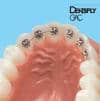
The findings appear in the journal The Angle Orthodontist.
The researchers looked at 34 patients with class I division 1 malocclusion and moderate crowding of upper teeth who were distributed randomly into two groups. The 17 patients in group A (mean age: 20.6 years; standard deviation [SD]: 2.9 years) were treated with fixed lingual appliances, while the 17 patients in group B (mean age: 21.8 years; SD: 3.3 years) were treated with conventional fixed labial appliances. To measure speech performance, the researchers tested patients using spectrographic analysis of fricative /s/ sound before, immediately after (T1), 1 month after, and 3 months after bracket placement. Levels of oral impairment were assessed using standardized questionnaires.
A significant deterioration in articulation was recorded at all assessment times in group A, but only at T1 in group B. The researchers also noted significant intergroup differences at all assessment times (P < .001). Speech difficulties were significantly higher in the lingual brackets group after 1 month of bracket placement (P < .001). Additionally, soft tissue irritation and chewing difficulty were significantly higher in the lingual appliance group after 24 hours of bracket placement (P < .001).





